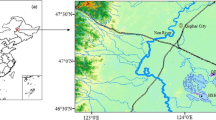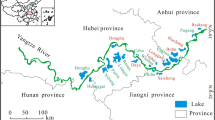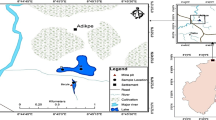Abstract
n-Alkanes are biomarkers that are widely used as paleoenvironmental reconstruction proxies in lacustrine sediments. However, studies on their sedimentation and factors affecting sedimentation in large lakes remain relatively scarce. In this study, 120 surface sediments collected from Selin Co, central Tibetan Plateau, were used to analyze the spatial distribution of n-alkanes in a modern sedimentary system, and the factors controlling this distribution were further discussed. The sedimentary n-alkanes of Selin Co were mainly long- and middle-chain components with single or double peaks, belonging to the mixed-type input of terrestrial and aquatic plants. Leaf waxes derived from terrestrial plants in the catchment of Selin Co were the main source followed by aquatic plants, while planktonic algae living in the lake water column was a minor source, as demonstrated by their low concentration. The distribution of aquatic and terrigenous n-alkanes in the surface sediments showed a significant spatial heterogeneity; this was controlled by different factors and sedimentary processes. The distribution of terrigenous n-alkanes was mainly controlled by underwater topography; high concentrations in the sedimentary center of the east lake basin and the sub-basin in the northwest were evident. Aquatic n-alkanes were found in substantially higher concentrations in the western estuary of Zhagen River and Ali River, as well as in the southern sub-basin, Yagen Co. These distributions might be influenced by differences of geographical environment in the watershed of these main inflow rivers, as well as the intensity of sunlight, itself intensity controlled by the transparency of the water column. Although n-alkanes from the center of a lake could represent an integration of catchments in most cases, their spatial heterogeneity in large lakes like Selin Co would introduce uncertainty to paleoenvironmental reconstructions. Consequently, it is very important to investigate thoroughly the spatial distribution and controlling factors of n-alkanes in modern lake environments. It is inferred that these findings will have broad significance in large lakes similar to Selin Co, and that they will benefit studies that use n-alkanes as proxies to reconstruct past environmental changes.








Similar content being viewed by others
References
Aboul-Kassim TAT, Simoneit BRT (1996) Lipid geochemistry of surficial sediments from the coastal environment of Egypt I. Aliphatic hydrocarbons—characterization and sources. Mar Chem 54:135–158
Anderson NJ (1990) Spatial pattern of recent sediment and diatom accumulation in a small, monomictic, eutrophic lake. J Paleolimnol 3:143–160
Baas M, Pancost R, Geel BV, Sinninghe Damsté JS (2000) A comparative study of lipids in sphagnum, species. Org Chem 31:535–541
Boer TAD (1983) Vegetation as an indicator of environmental changes. Environ Monit Assess 3:375–380
Bush RT, Mcinerney FA (2013) Leaf wax n-alkane distributions in and across modern plants: implications for paleoecology and chemotaxonomy. Geochim Cosmochim Acta 117:161–179
Claussen M, Bathiany S, Brovkin V, Kleinen T (2014) Abrupt or not abrupt—biodiversity affects climate–vegetation interaction at the end of the African Humid Period. EGU General Assembly Conference Abstracts
Cranwell PA (1973) Chain-length distribution of n-alkanes from lake sediments in relation to post-glacial environmental change. Freshw Biol 3:259–265
Dean WE (2010) Recent advances in global lake coring hold promise for global change research in. J paleolimnol 44:741–743
Deyang ZJ, Nima J, Qiangba OZ, Zeng L, Luosang QZ (2018) The change of lake area and its influencing factors in watershed of Selin Co in Tibet recent 40 years. Plateau Mt Meteorol Res 38(2):35–41 (in Chinese)
Dong J, Wang Y, Zhang SH, Chi ZQ, Yao PY, Zhao ZL (2012) Environmental magnetic comparisons between distal and proximal sediments of Huangqihai Lake, Inner Mongolia, China. Sci China Earth Sci 55(9):1494–1503
Downing JA, Rath LC (1988) Spatial patchiness in the lacustrine sedimentary environment. Limnol Oceanogr 33:447–458
Duan Y, Xu L (2012) Distributions of n-alkanes and their hydrogen isotopic composition in plants from Lake Qinghai (China) and the surrounding area. Appl Geochem 27:806–814
Eglinton TI, Eglinton G (2008) Molecular proxies for paleoclimatology. Earth Planet Sci Lett 275:1–16
Eglinton G, Hamilton RJ (1967) Leaf epicuticular waxes. Science 156:1322–1335
Elias VO, Cardoso JN, Simoneit BRT (2000) Acyclic lipids in amazon shelf waters. Estuar Coast Shelf Sci 50:231–243
Ficken KJ, Li B, Swain DL, Eglinton G (2000) An n-alkane proxy for the sedimentary input of submerged/floating freshwater aquatic macrophytes. Org Chem 31:745–749
Gilbert R (2003) Spatially irregular sedimentation in a small morphologically complex lake implications for paleoenvironmental studies. J Paleolimnol 29:209–220
Gogou A, Bouloubassi I, Stephanou EG (2000) Marine organic geochemistry of the eastern mediterranean: 1. Aliphatic and polyaromatic hydrocarbons in cretan sea surficial sediments. Mar Chem 68:265–282
Gu ZY, Liu JQ, Yuan BY (1993) Monsoon variations of the Qinghai–Xizang Plateau during the last 12,000 years-Geochemical evidence from the sediments in the Siling Lake. Chin Sci Bull 38:577–577
Gyawali AR, Wang JB, Ma QF, Wang Y, Xu T, Guo Y, Zhu LP (2019) Paleo-environmental change since the Late Glacial inferred from lacustrine sediment in Selin Co, central Tibet. Palaeogeogr Palaeocl 516:101–112
Han J, Calvin M (1969) Hydrocarbon distribution of algae and bacteria, and microbiological activity in sediments. Proc Natl Acad Sci 64:436–443
Harji RR, Yvenat A, Bhosle NB (2008) Sources of hydrocarbons in sediments of the Mandovi estuary and the Marmugoa Harbour, West coast of India. Environ Int 34:959–965
He YX, Zheng YW, Pan AD, Zhao C, Sun YY, Song M, Zheng Z, Liu ZH (2014) Biomarker-based reconstructions of Holocene lake-level changes at Lake Gahai on the northeastern Tibetan Plateau. Holocene 24:405–412
Hedges JI (1977) The association of organic molecules with clay minerals in aqueous solutions. Geochim Cosmochim Acta 41:1119–1123
Henderson ACG, Holmes JA (2009) Palaeolimnological evidence for environmental change over the past millennium from lake Qinghai sediments: a review and future research prospective. Quatern Int 194:134–147
Hilton J (1985) Conceptual framework for predicting the occurrence of sediment focusing and sediment redistribution in small lakes. Limnol Oceanogr 30:1131–1143
Hilton J (1986) The dominant processes of sediment distribution and focusing in a small, eutrophic, Monomictic lake. Limnol Oceanogr 31:125–133
Johnson TC, Kelts K, Odada E (2000) The holocene history of lake victoria. Ambio J Hum Environ 29:2–11
Ju JT, Zhu LP, Wang JB, Xie MP, Zhen XL, Wang Y, Peng P (2010) Water and sediment chemistry of Lake Pumayum Co, South Tibet, China: implications for interpreting sediment carbonate. J Paleolimnol 43:463–474
Kashiwaya K, Masuzawa T, Morinaga H, Yaskawa K, Yuan BY, Liu JQ, Gu ZY (1995) Changes in hydrological conditions in the central Qing-Zang (Tibetan) plateau inferred from Lake Bottom sediments. Earth Planet Sci Lett 135:31–39
Kastner S, Ohlendorf C, Haberzettl T, Lücke A, Mayr C, Maidana NI, Schabitz F, Zolitschka B (2010) Southern hemispheric westerlies control the spatial distribution of modern sediments in Laguna Potrok Aike, Argentina. J Paleolimnol 44:887–902
Keeley JE, Sandquist DR (1991) Diurnal photosynthesis cycle in cam and non-cam seasonal-pool aquatic macrophytes. Ecology 72:716–727
Kemp MW, Batleson R, Bergstrom P, Carter V, Gallegos CL, Hunley W, Karrh L, Koch EW, Landwehr JM, Moore KA, Murray L, Naylor M, Rybicki NB, Court Stevenson J, Wilcox DJ (2004) Habitat requirements for submerged aquatic vegetation in Chesapeake Bay: water quality, light regime, and physical–chemical factors. Estuar Coast 27:363–377
Lamoureaux S (1999) Spatial and interannual variations in sedimentation patterns recorded in nonglacial varved sediments from the Canadian High Arctic. J Paleolimnol 21:73–84
Li DW, Li YK, Ma BQ, Dong GC, Wang LQ, Zhao JX (2009) Lake-level fluctuations since the last glaciation in Selin Co (Lake), Central Tibet, investigated using optically stimulated luminescence dating of beach ridges. Environ Res Lett 4:045204
Lin X, Zhu LP, Wang Y, Wang JB, Xie MP, Ju JT, Mäusbacher R, Schwalb A (2008) Environmental changes reflected by n-alkanes of lake core in Nam Co on the Tibetan Plateau since 8.4 kaB.P. Sci Bull 53:3051–3057
Lin X, Zhu LP, Wang JB, Wang Y, Zheng XL, Ju JT, Xie MP, Peng P (2009) Sources and spatial distribution character of n-alkanes in surface sediments of Nam Co on the Tibetan Plateau. J Lake Sci 21(5):654–662 (in Chinese)
Liu JK (1999) Advances Aquatic Biology. Science Press, Beijing, pp 176–196 (in Chinese)
Liu XD, Chen BD (2000) Climatic warming in the Tibetan Plateau during recent decades. Int J Climatol 20:1729–1742
Liu H, Liu WG (2016) n-Alkane distributions and concentrations in algae, submerged plants and terrestrial plants from the Qinghai-Tibetan Plateau. Org Geochem 99:10–22
Liu WG, Yang H, Wang HY, An ZS, Wang Z, Leng Q (2015) Carbon isotope composition of long chain leaf wax n-alkanes in lake sediments: a dual indicator of paleoenvironment in the Qinghai-Tibet Plateau. Org Geochem 83:190–201
Madsen TV, Maberly SC (2010) Diurnal variation in light and carbon limitation of photosynthesis by two species of submerged freshwater macrophyte with a differential ability to use bicarbonate. Freshw Biol 26:175–187
Maioli OLG, Rodrigues KC, Knoppers BA, Azevedo DA (2010) Pollution source evaluation using petroleum and aliphatic hydrocarbons in surface sediments from two Brazilian estuarine systems. Org Geochem 41:966–970
Mead R, Xu Y, Chong J, Jaffé R (2005) Sediment and soil organic matter source assessment as revealed by the molecular distribution and carbon isotopic composition of n-alkanes. Org Geochem 36:363–370
Meng K, Shi XH, Wang E, Liu F (2012) High-altitude salt lake elevation changes and glacial ablation in Central Tibet, 2000–2010. Chin Sci Bull 57:525–534
Meyers P (2003) Applications of organic geochemistry to paleolimnological reconstructions: a summary of examples from the Laurentian Great Lakes. Org Geochem 31:261–289
Meyers P, Lallier-Vergés E (1999) Lacustrine sedimentary organic matter records of late quaternary paleoclimates. J Paleolimnol 21:345–372
Morinaga H, Itota C, Isezaki N, Goto H, Yaskawa K, Kusakabe M, Liu J, Gu ZY, Yuan BY, Cong S (1993) Oxygen-18 and carbon-13 records for the last 14,000 years from Lacustrine carbonates of Siling-Co (Lake) in the Qinghai-Tibetan Plateau. Geophys Res Lett 20:2909–2912
Neupane B, Wang JB, Kang SC, Zhang YL, Chen PF, Rai M, Guo JM, Yu SW, Thapa P (2020) Black carbon and mercury in the surface sediments of Selin Co, central Tibetan Plateau: covariation with total carbon. Sci Total Environ 721:137752
Nichols JE, Booth RK, Jackson ST, Pendall EG, Huang Y (2006) Paleohydrologic reconstruction based on n -alkane distributions in ombrotrophic peat. Org Geochem 37:1505–1513
Ohkouchi N, Kawamura K, Taira A (1997) Molecular paleoclimatology: reconstruction of climate variabilities in the late Quaternary. Org Geochem 27:173–183
Pancost RD, Boot CS (2004) The palaeoclimatic utility of terrestrial biomarkers in marine sediments. Mar Chem 92:239–261
Pedersen O, Colmer TD, Sand-Jensen K (2013) Underwater photosynthesis of submerged plants-recent advances and methods. Front Plant Sci 4:140
Peters KE, Walters CC, Moldowan JM (2005) The biomarker guide. Biomark Isot Pet Syst Earth Hist Ed 2:490
Raven JA, Hurd CL (2012) Ecophysiology of photosynthesis in macroalgae. Photosynth Res 113:105–125
Rieley G (1991) The biogeochemistry of Ellesmere lake, UK. 1. Source correlation of leaf wax inputs to the sedimentary lipid record. Org Chem 17:901–912
Rooney N, Kalff J (2000) Inter-annual variation in submerged macrophyte community biomass and distribution: the influence of temperature and lake morphometry. Aquat Bot 68:321–335
Rowley DB, Currie BS (2006) Palaeo-altimetry of the late Eocene to Miocene Lunpola Basin, central Tibet. Nature 439:677–681
Sarkar S, Wilkes H, Prasad S, Brauer A, Riedel N, Stebich M, Basavaiah N, Sachse D (2014) Spatial heterogeneity in lipid biomarker distributions in the catchment and sediments of a crater lake in central India. Org Geochem 66:125–136
Schefuß E, Ratmeyer V, Stuut JW, Jansen JHF, Sinninghe Damsté JS (2003) Carbon isotope analyses of n-alkanes in dust from the lower atmosphere over the central eastern Atlantic. Geochim Cosmochim Acta 67:1757–1767
Schiefer E (2006) Depositional regimes and areal continuity of sedimentation in a montane Lake Basin, British Columbia, Canada. J Paleolimnol 35:617–628
Seki O, Meyers PA, Kawamura K, Zheng YH, Zhou WJ (2009) Hydrogen isotopic ratios of plant wax n-alkanes in a peat bog deposited in northeast China during the last 16kyr. Org Geochem 40:671–677
Street JH, Anderson RS, Rosenbauer RJ, Paytan A (2013) n-Alkane evidence for the onset of wetter conditions in the Sierra Nevada, California (USA) at the mid-late Holocene transition, ~ 3.0 ka. Quat Res 79:14–23
Su R, Li W (2005) Advances in research on photosynthesis of submerged macrophytes. Chin Bull Bot 22:128–138
Sun XJ, Du NQ, Chen YS, Gu ZY, Liu JQ, Yuan BY (1993) Holocene palynological records in lake Selincuo, northern XiZang. Acta Bot Sin 35(12):943–950 (in Chinese)
Tong K, Su FG, Xu BQ (2016) Quantifying the contribution of glacier meltwater in the expansion of the largest lake in Tibet. J Geophys Res 121:11158–11173
Twilley RR, Barko JW (1990) The growth of submersed macrophytes under experimental salinity and light conditions. Estuar Coast 13:311
Vogel H, Wessels M, Albrecht C, Stich HB, Wagner B (2010) Spatial variability of recent sedimentation in Lake Ohrid (Albania/Macedonia). Biogeosciences 7:3333–3342
Wang D (2003) The geography of aquatic vascular plants of Qinghai-Xizang (Tibet) Plateau. Dissertation for Doctoral Degree Wuhan University, p 190 (in Chinese)
Wang JB, Zhu LP, Nishimura M, Nakamura T, Ju JT, Xie MP, Takahiro W, Testsuya M (2009) Spatial variability and correlation of environmental proxies during the past 18,000 years among multiple cores from Lake Pumoyum Co, Tibet, China. J Paleolimnol 42:303–315
Wang JB, Zhu LP, Wang Y, Ju JT, Xie MP, Daut G (2010) Comparisons between the chemical compositions of lake water, inflowing river water, and lake sediment in Nam Co, central Tibetan Plateau, China and their controlling mechanisms. J Great Lakes Res 36:587–595
Wang Y, Zhu LP, Wang JB, Ju JT, Lin X (2012) The spatial distribution and sedimentary processes of organic matter in surface sediments of Nam Co, Central Tibetan Plateau. Chin Sci Bull 57:4753–4764
Wang JB, Zhu LP, Wang Y, Ju JT, Daut G, Li MH (2015) Spatial variability and the controlling mechanisms of surface sediments from Nam Co, central Tibetan Plateau, China. Sediment Geol 319:69–77
Wang Y, Wang JB, Zhu LP, Lin X, Hu JF, Ma QF, Ju JT, Peng P, Yang RM (2017) Mid- to late-Holocene paleoenvironmental changes inferred from organic geochemical proxies in Lake Tangra Yumco, Central Tibetan Plateau. The Holocene 27:1475–1486
Wang C, Wang HL, Song G, Zheng MP (2019) Grain size of surface sediments in Selin Co (central Tibet) linked to water depth and offshore distance. J Paleolimnol 61:217–229
Wu ZH, Ye PS, Barosh PJ, Hu DG, Lu L, Zhang YL (2012) Early cenozoic mega thrusting in the Qiangtang block of the northern Tibetan Plateau. Acta Geol Sin 86(4):799–809
Yu ZT, Wang XJ, Zhang EL, Zhao YC, Liu XQ (2015) Spatial distribution and sources of organic carbon in the surface sediment of Bosten lake, China. Biogeosciences 12(22):6605–6615
Yu SW, Wang JB, Li YM, Peng P, Kai JL, Kou QQ, Laug A (2019) Spatial distribution of diatom assemblages in the surface sediments of Selin Co, central Tibetan Plateau, China, and the controlling factors. J Great Lakes Res 45:1069–1079
Zhang YS, Yao TD, Ma YZ (2011) Climatic changes have led to significant expansion of Endorheic Lakes in Xizang (Tibet) since 1995. Sci Cold Arid Reg 3(6):463–467
Zhao MX, Dupont L, Eglinton G, Teece M (2003) n-Alkane and pollen reconstruction of terrestrial climate and vegetation for N.W. Africa over the last 160 kyr. Org Geochem 34:131–143
Zhou WJ, Xie SC, Meyers PA, Zheng YH (2005) Reconstruction of late glacial and Holocene climate evolution in southern China from geolipids and pollen in the Dingnan peat sequence. Org Geochem 36:1272–1284
Zhou J, Wang L, Zhang YS, Guo YH, Li XP, Liu WB (2015) Exploring the water storage changes in the largest lake (Selin Co) over the Tibetan Plateau during 2003–2012 from a basin-wide hydrological modeling. Water Resour Res 51:8060–8086
Zhou J, Wang L, Zhang YS, Guo YH, He D (2016) Spatiotemporal variations of actual evapotranspiration over the Lake Selin Co and surrounding small lakes (Tibetan Plateau) during 2003–2012. Sci China Earth Sci 59:2441–2453
Zhu LP, Wu YH, Wang JB, Lin X, Ju JT, Xie MP, Li MH, Maeusbacher R, Schwalb A, Daut G (2008) Environmental changes since 8.4 ka reflected in the lacustrine core sediments from Nam Co, central Tibetan Plateau, China. Holocene 18:831–839
Zhu LP, Wang JB, Ju JT, Ma N, Zhang YS, Liu C, Han BP, Liu LS, Wang MD, Ma QF (2019) Climatic and lake environmental changes in the Serling Co region of Tibet over a variety of timescales. Sci Bull 64:422–424
Acknowledgements
This work was jointly supported by the National Natural Science Foundation of China (41330103), the Second Tibetan Plateau Scientific Expedition and Research Program (STEP) (2019QZKK0202), the Strategic Priority Research Program of the Chinese Academy of Sciences (XDA20070101), the National Natural Science Foundation of China (41571189) and the Open Research Fund of Key Laboratory of Tibetan Environmental Changes and Land Surface Processes, Chinese Academy of Sciences (TEL201604). We are grateful to Teng Xu, Hao Chen, Baoqi Jiang, Chong Liu, Yongchong Lin, and Qiong Wang for their assistance in the field. We are also grateful to Chief editor Thomas J. Whitmore, associate editor Dr. Cheng Zhao and anonymous reviewers for constructive comments which improved the manuscript.
Author information
Authors and Affiliations
Corresponding authors
Additional information
Publisher's Note
Springer Nature remains neutral with regard to jurisdictional claims in published maps and institutional affiliations.
Rights and permissions
About this article
Cite this article
Kou, Q., Lin, X., Wang, J. et al. Spatial distribution of n-alkanes in surface sediments of Selin Co Lake, central Tibetan Plateau, China. J Paleolimnol 65, 53–67 (2021). https://doi.org/10.1007/s10933-020-00148-8
Received:
Accepted:
Published:
Issue Date:
DOI: https://doi.org/10.1007/s10933-020-00148-8




